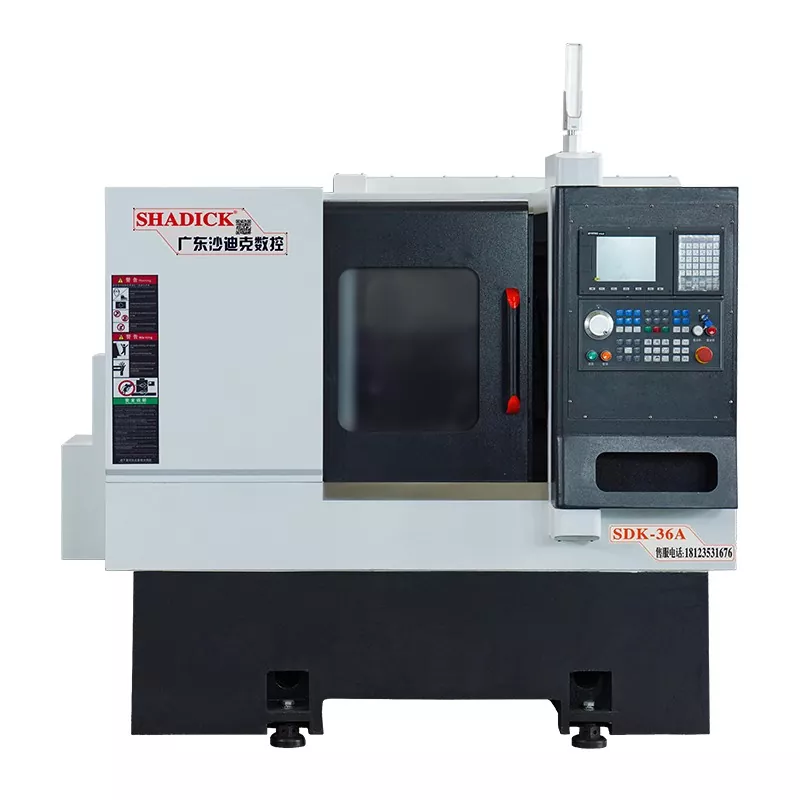
- English
- Español
- Português
- русский
- Français
- 日本語
- Deutsch
- tiếng Việt
- Italiano
- Nederlands
- ภาษาไทย
- Polski
- 한국어
- Svenska
- magyar
- Malay
- বাংলা ভাষার
- Dansk
- Suomi
- हिन्दी
- Pilipino
- Türkçe
- Gaeilge
- العربية
- Indonesia
- Norsk
- تمل
- český
- ελληνικά
- український
- Javanese
- فارسی
- தமிழ்
- తెలుగు
- नेपाली
- Burmese
- български
- ລາວ
- Latine
- Қазақша
- Euskal
- Azərbaycan
- Slovenský jazyk
- Македонски
- Lietuvos
- Eesti Keel
- Română
- Slovenski
How CNC machine tools work?
2025-10-14
Structural Features of the CNC Tool Arrangement Machine
The CNC tool arrangement machine can complete multiple processes simultaneously, including external turning, polygon milling, threading, and grooving.
It can handle a variety of processes, including high-speed turning and low-speed polygon milling.
A hydraulic clamping device improves the machine's level of automation.
The machine foot is integrated and utilizes imported linear guides, offering excellent vibration resistance and high rigidity.
High-quality cast iron resin sand molding and a compact ribbed plate structure provide excellent rigidity and strong vibration resistance.
It features high-rigidity, high-precision, and high-speed linear guides and precision ball screws.
How to Change Tools on a CNC Machine Tool
1. Changing Tools with a Rotary Toolholder
A rotary toolholder is a simple automatic tool changer commonly used in CNC automated machine tools. It can be designed in various configurations, including square, hexagonal, or disc-type axial toolholders. Each rotary toolholder holds four, six, or more tools, and tools are changed according to commands from the CNC device.
The rotary toolholder must possess sufficient structural strength and rigidity to withstand the cutting forces during rough machining. Since turning accuracy depends largely on tool tip position, CNC machine tools require no manual adjustment of tool position during machining. Therefore, a reliable positioning solution and a suitable positioning structure are essential to ensure the highest possible repeatability (typically 0.001 to 0.005 mm) after each indexing of the rotary toolholder.
2. Tool Changing by Replacing the Spindle Head
Tool changing by replacing the spindle head is a relatively simple tool changing method for CNC machine tools equipped with rotating tools. This type of spindle head is essentially a turret tool magazine. Spindle heads are available in both horizontal and vertical configurations. The turret is typically rotated to change the spindle head, enabling automatic tool changing. Each spindle in the turret is pre-installed with the rotating tool required for each process. When a tool change command is issued, each spindle head rotates to the processing position in sequence and engages the main motion, causing the corresponding spindle to rotate the tool. Other spindles in non-processing positions are disengaged from the main motion.
3. Automatic Tool Changing System with Tool Magazine
Because rotary tool holders and turret-type tool changers cannot accommodate a large number of tools and cannot meet the machining needs of complex parts, CNC machine tools with automatic tool change often use an automatic tool changer with a tool magazine. This automatic tool changer consists of a tool magazine and a tool changing mechanism, and the tool changing process is relatively complex. First, all tools used in the machining process must be mounted on standard toolholders, pre-sized outside the machine, and then placed in the tool magazine according to a specific arrangement. When changing tools, a tool is selected from the magazine. The tool changer then removes the tool from the magazine or spindle, swaps the tool, and installs the new tool into the spindle, returning the old tool to the magazine. The tool magazine has a large capacity and can be mounted on the side or above the spindle box. Since CNC machine tools with automatic tool changers have only one spindle in the headstock, the spindle assembly must be highly rigid to meet the requirements of precision machining.
| Processing Stage | Description |
|---|---|
| Pre-processing | Part drawing analysis: clarify shape, dimensions, tolerances, and determine the process route Tool and fixture preparation: select tools and fixtures to ensure fixation and accuracy CNC machine inspection: check machine components and adjust machinery |
| Program Compilation | Compile processing program: set paths and parameters Program verification and input: detect errors and ensure accuracy |
| Part Processing | Clamping and tool alignment: install part and measure tool position Auto processing: start machine and monitor processing |
| Post-processing | Part inspection: check dimensions and accuracy Cleaning and maintenance: clean machinery and maintain equipment |




